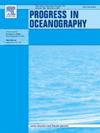季节性对热带海洋顶级捕食者觅食行为和繁殖成功的影响
IF 3.6
3区 地球科学
Q1 OCEANOGRAPHY
引用次数: 0
摘要
在极地和温带地区,环境条件的季节性是动物物候学的重要驱动因素。在全年环境相对均匀的热带系统中,物候和季节性之间的联系被削弱,许多物种不同步繁殖,甚至全年繁殖。这就引出了这些物种如何适应季节变化的问题,尽管这种变化在较小程度上仍然存在。为了评估觅食可塑性与海洋条件和资源可用性的季节变化之间的关系,我们研究了红嘴热带鸟(Phaethon aethereus)的觅食生态学,这是一种在佛得角全年繁殖的泛热带物种。从2017年到2022年,我们在三个岛屿(Boavista、Sal和Cima岛)监测了热带鸟的巢穴,并跟踪了329只成年鸟的907次觅食行程,以评估巢占用、觅食模式和效率、雏鸟生长、雏鸟和成年鸟的身体状况、繁殖成功率以及资源可用性和环境条件的季节性变化。我们发现了觅食行为的季节性模式,个体的觅食路程更远,曲折较少,使用更大的核心觅食区域,在黄昏时花费更多的时间觅食,在旱季(12月- 6月)比在雨季(7月- 11月)消耗更多的鱿鱼。此外,巢占率、雏鸟体况和繁殖成功率在旱季均较高。我们认为,观察到的季节模式与旱季结束时鱿鱼的可得性增加有关,而在雨季,筑巢适宜性降低,与天气相关的觅食成本增加有关。我们的研究结果首次深入了解了热带海鸟觅食行为的季节变化,表明热带系统中的季节性可能比以前认为的更强烈地推动了顶级捕食者的运动。本文章由计算机程序翻译,如有差异,请以英文原文为准。
The effect of seasonality on the foraging behaviour and breeding success of a tropical marine top predator
In polar and temperate regions seasonality in environmental conditions is an important driver of animal phenology. In tropical systems, where the environment is relatively homogeneous year-round, the link between phenology and seasonality is weakened, and many species breed asynchronously or even year-round. This leads to the question of how these species adapt to seasonal changes, which remain present albeit to a lesser extent. To assess relationships between foraging plasticity and seasonal changes in oceanographic conditions and resource availability, we investigated the foraging ecology of the red-billed tropicbird (Phaethon aethereus), a poorly studied pantropical species that breeds year-round in Cabo Verde. From 2017 to 2022, we monitored tropicbird nests at three islands (Boavista, Sal and the Cima Islet) and GPS tracked 907 foraging trips from 329 adults to evaluate seasonality in nest occupancy, foraging patterns and efficiency, chick growth, chick and adult body condition, and breeding success, alongside links to seasonal changes in resource availability and environmental conditions. We found seasonal patterns in foraging behaviour, with individuals taking more distant and less sinuous foraging trips, using a larger core foraging area, spending more time foraging during twilight, and consuming more squid in the dry season (December-June), than in the wet season (July-November). Moreover, nest occupancy, chick body condition and breeding success were higher in the dry season. We suggest that the observed seasonal patterns are related to an increase in the availability of squid at the end of the dry season, and a decrease in the nest-site suitability and an increase in weather-related foraging costs in the wet season. Our results provide some of the first in-depth knowledge on the seasonal variation in foraging behaviour of a tropical seabird species, suggesting seasonality in tropical systems may be a stronger driver of the movements of top predators than previously thought.
求助全文
通过发布文献求助,成功后即可免费获取论文全文。
去求助
来源期刊

Progress in Oceanography
地学-海洋学
CiteScore
7.20
自引率
4.90%
发文量
138
审稿时长
3 months
期刊介绍:
Progress in Oceanography publishes the longer, more comprehensive papers that most oceanographers feel are necessary, on occasion, to do justice to their work. Contributions are generally either a review of an aspect of oceanography or a treatise on an expanding oceanographic subject. The articles cover the entire spectrum of disciplines within the science of oceanography. Occasionally volumes are devoted to collections of papers and conference proceedings of exceptional interest. Essential reading for all oceanographers.
 求助内容:
求助内容: 应助结果提醒方式:
应助结果提醒方式:


